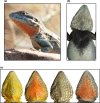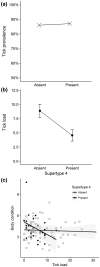Specific MHC class I supertype associated with parasite infection and color morph in a wild lizard population
- PMID: 30386586
- PMCID: PMC6202711
- DOI: 10.1002/ece3.4479
Specific MHC class I supertype associated with parasite infection and color morph in a wild lizard population
Abstract
The major histocompatibility complex (MHC) is a large gene family that plays a central role in the immune system of all jawed vertebrates. Nonavian reptiles are underrepresented within the MHC literature and little is understood regarding the mechanisms maintaining MHC diversity in this vertebrate group. Here, we examined the relative roles of parasite-mediated selection and sexual selection in maintaining MHC class I diversity of a color polymorphic lizard. We discovered evidence for parasite-mediated selection acting via rare-allele advantage or fluctuating selection as ectoparasite load was significantly lower in the presence of a specific MHC supertype (functional clustering of alleles): supertype four. Based on comparisons between ectoparasite prevalence and load, and assessment of the impact of ectoparasite load on host fitness, we suggest that supertype four confers quantitative resistance to ticks or an intracellular tickborne parasite. We found no evidence for MHC-associated mating in terms of pair genetic distance, number of alleles, or specific supertypes. An association was uncovered between supertype four and male throat color morph. However, it is unlikely that male throat coloration acts as a signal of MHC genotype to conspecifics because we found no evidence to suggest that male throat coloration predicts male mating status. Overall, our results suggest that parasite-mediated selection plays a role in maintaining MHC diversity in this population via rare-allele advantage and/or fluctuating selection. Further work is required to determine whether sexual selection also plays a role in maintaining MHC diversity in agamid lizards.
Keywords: Agamidae; Ctenophorus decresii; MHC‐associated mating; major histocompatibility complex; parasite‐mediated selection.
Figures




References
-
- Allison, B. , & Desser, S. S. (1981). Developmental Stages of Hepatozoon lygosomarum (Doré 1919) comb. n. (Protozoa: Haemogregarinidae), a Parasite of a New Zealand Skink, Leiolopisma nigriplantare. The Journal of Parasitology, 67, 852–858. 10.2307/3280710 - DOI
-
- Bartoń, K. (2009). MuMIn: Multi‐model inference, p. R package.
Associated data
LinkOut - more resources
Full Text Sources
Other Literature Sources
Research Materials

